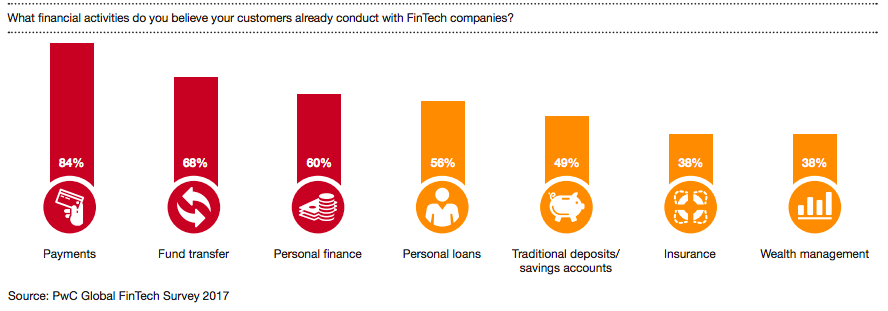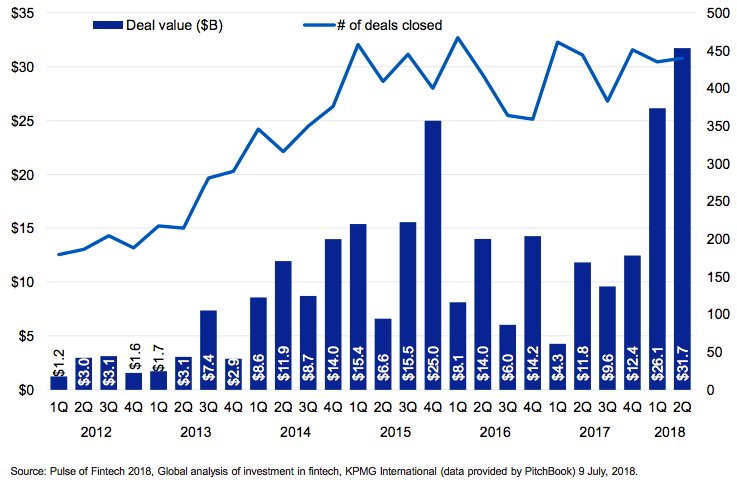"There are hundreds of startups with a lot of brains and money working on various alternatives to traditional banking" - Jamie Dimon, CEO, JPMorgan Chase
FinTech and the disruption it can cause to the traditional banking systems is now a hot topic of debate in the banking conferences. Global venture capital funds are super-bullish on this front and are accentuating investments in the FinTech companies. Thanks to the burgeoning demand of FinTech in recent times, more crowdsourcing platforms are letting artists or fledgling entrepreneurs to crowd-source capital from a large constituency of online donors or investors.

For instance, peer to peer (P2P) lending, the high-tech equivalent of borrowing money from friends, helps in raising a loan from an online community at a mutually negotiated interest rate. Also, digital wallet providers allow people to zip money across borders even without any bank accounts using handheld devices.
Amalgamation of these technologies, which goes under the umbrella term FinTech, is expected to metamorphose the way all of us use banking and financial services. And Drupal can act as the perfect content management framework for building a great FinTech platform.
A portmanteau of financial technology
Financial technology, which is referred to as FinTech, illustrates the evolving intersection of financial services and technology. FinTech allows people to innovate while transacting business ranging from digital money to double-entry bookkeeping.
The lines between technology and the financial services are blurring
Since the advent of the internet revolution and later the mobile internet revolution, financial technology has grown multifold. Originally referred to technology applied to the back office of banks or trading firms, FinTech now caters to a broad variety of technological interventions into personal and commercial finance.
According to EY’s FinTech Adoption Index, one-third of consumers leverage at least two or more FinTech services and more and more of these consumers are also aware of FinTech being a part of their daily lives.
FinTech encompasses the startups, technology companies or even legacy providers. Startups use technology to offer existing financial services at affordable costs and to provide new tech-driven solutions. Incumbent financial enterprises look to acquire or work with startups to drive digital innovation. Technology companies offer payment tools. All these can be seen as FinTech. Surely, the lines between technology and the financial services are blurring.
Origins of FinTech

In broad lines, the financial industry has seen a gargantuan shift over the years with the way it is leveraged in the times of rapid technological advancements. 16Best has compiled a brief history of FinTech which shows how the gap between financial services and the technology has got bridged over the years.
The gap between financial services and the technology has got bridged over the years.
In 1918, the Fedwire Funds service began offering electronic funds transfer. And while the Great Depression was ravaging the world’s economies, IBM provided some solace with its 801 Bank Proof Cach Machine that offered the means for faster cheque processing. Subsequently, credit cards and ATMs came into existence in the ‘50s and ‘60s.
In 1971, first all-electronic trading emerged in the form of NASDAQ. And in 1973, the SWIFT (Society for Worldwide Interbank Financial Telecommunications) built a unified messaging framework between banks for handling money movement.
1997 was the year which saw the emergence of mobile payment through Coca-Cola Vending Machine. Fast forward to 2000s and the present decade, a slew of innovations crashed into the finance sector with the introduction of digital wallets, contactless payments and cryptocurrencies.
FinTech is definitely re-inventing a quicker and more durable wheel as the world continues to witness a superabundance of new ventures refining financial services with technology.
Merits of FinTech

Financial technology has taken the financial services to a whole new level with a cluster of merits that it offers. Here are some of the major benefits of FinTech:
- Robo Advisors: They are one of the biggest areas of FinTech. These online investment services put users through a slew of questions and then relies on algorithms to come up with an investment plan for them.
- Online Lending: It encompasses all aspects of borrowing from personal loans to refinancing student loans which improves money lending.
- Mobile payments: There is a growing demand for mobile payment options with the stupendous rise of mobile devices over the years.

Personal Finance and Savings: A plethora of FinTech organisations in the micro saving department have been helping people to save their change for rainy days and a whole lot of them rewarding customers for doing so. For instance, Digit allows you to automate the process of saving extra cash.

Online Banking and Budgeting: Online banks like Simple reward users for using their ‘automatic savings’ service and also offer a cost-effective option over a traditional bank. Leveraging online tools, they assist users to plan budgets and handle their money smartly from their mobile devices with minimal effort to meet their savings goals.
Insurance: New insurance models have been strengthening the FinTech space. Metromile, an insurance model, sells pay per mile car insurance.

Regtech: Regulation Technology, which utilises IT to enhance regulatory processes, is one of the significant sectors where numerous FinTech app ideas have come into light around this domain. Regtech is useful for trading in financial markets, monitoring payment transactions and identification of clients among others. For instance, PassFort helps in standardising the online compliance processes.
How is Drupal powering FinTech?
Organisations offering FinTech solutions need to maintain a robust online presence. Drupal has been powering the landscape of FinTech with its enormous capabilities.
The launch of TPG Capital

TPG Capital is one of the major enterprise-level FinTech companies which has leveraged the power of Drupal 8.
One of the primary objectives for TPG’s marketing circuit was to harness the Drupal’s flexibility as a digital empowerment platform. They wanted the ability to make alterations to content on the fly and try out new messaging approaches. Simultaneously, the financial industry’s stringent legal and regulatory requirements called for a flexible TPG platform that would meet the specific needs of the sector thereby offering top-notch security.
Drupal came out as the right choice when it came to the CMS that would facilitate the TPG’s goal for mirroring their cutting-edge business practices and incorporate modern website design and branding.
A digital agency built a responsive, mobile-first site. It featured newer CSS features like Flexbox and CSS animations and minimised the site’s dependence on Compass by introducing auto prefixer. Moreover, Drupal 8 version of Swifttype was built for the search component and contributed back to the Drupal Community.
The launch of Tech Coast Angels

Tech Coast Angels are one of the biggest angel investment organisation in the US.
Tech Coast Angels selected Drupal as their CMS of choice for its excellent features vis-à-vis user authentication, account management, roles and access control, custom dashboards, intricate web forms for membership and funding application, workflow management and email notifications.
Performance improvements were made by a digital agency to both the Drupal application and the server environments which brought down the costs to a huge extent by minimising the hardware requirements necessary to run the Drupal codebase in both staging and production environments.
With Drupal being one of the most security focussed CMSs, it helped a great deal in making amendments related to security of the site. Views caching were enabled and unnecessary modules were turned off on the production server.
Market trends

The Pulse of FinTech 2018 by KPMG shows that global investments activity in FinTech companies has been steadily rising with 2018 turning out as the most profitable year. It is only going to grow more in the coming years.

In the coming years, the main trends in the asset and wealth management, banking, insurance and transactions and payments services industries can be seen in the illustration above.
Conclusion
FinTech is a great alternative to traditional banks. FinTech excels where traditional banks lag behind. In addition to offering robust financial services leveraging technological advancements, organisations offering FinTech solutions need to have a superb digital presence to offer a great digital experience. Drupal can be an awesome content store for an enterprise-level FinTech platform.
Drupal experts at Opensense Labs have been powering digital transformation pursuits of organisations offering a suite of services.
Contact us at [email protected] to build a FinTech web application for your business using Drupal.
Subscribe
Related Blogs
Inside the Drupal AI Summit: Themes, Speaker and What To Expect

“ The web is changing fast, and AI is rewriting the rules. It writes content, builds pages, and answers questions directly,…
FOST and Drupal AI Initiative: Next Era of Responsible AI

Three years after the launch of generative AI tools marked a new age for artificial intelligence, almost 90% of survey…
Drupal AI Ecosystem Part 5: AI Content Suggestions

Drupal has steadily evolved from being just a content management system into a flexible platform that incorporates emerging…




